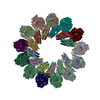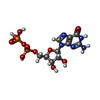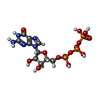+ Open data
Open data
- Basic information
Basic information
| Entry | Database: PDB / ID: 7un1 | |||||||||||||||||||||
|---|---|---|---|---|---|---|---|---|---|---|---|---|---|---|---|---|---|---|---|---|---|---|
| Title | 8-nm repeat of the human sperm tip singlet microtubule | |||||||||||||||||||||
 Components Components |
| |||||||||||||||||||||
 Keywords Keywords | STRUCTURAL PROTEIN / cilia / microtubule / sperm / cell motility | |||||||||||||||||||||
| Function / homology |  Function and homology information Function and homology informationaxonemal microtubule doublet inner sheath / axoneme assembly / Post-chaperonin tubulin folding pathway / axonemal microtubule / Cilium Assembly / cytoskeleton-dependent intracellular transport / organelle transport along microtubule / Microtubule-dependent trafficking of connexons from Golgi to the plasma membrane / Carboxyterminal post-translational modifications of tubulin / forebrain morphogenesis ...axonemal microtubule doublet inner sheath / axoneme assembly / Post-chaperonin tubulin folding pathway / axonemal microtubule / Cilium Assembly / cytoskeleton-dependent intracellular transport / organelle transport along microtubule / Microtubule-dependent trafficking of connexons from Golgi to the plasma membrane / Carboxyterminal post-translational modifications of tubulin / forebrain morphogenesis / Intraflagellar transport / Sealing of the nuclear envelope (NE) by ESCRT-III / cerebellar cortex morphogenesis / Formation of tubulin folding intermediates by CCT/TriC / glial cell differentiation / dentate gyrus development / neuron projection arborization / flagellated sperm motility / Gap junction assembly / Prefoldin mediated transfer of substrate to CCT/TriC / Kinesins / COPI-independent Golgi-to-ER retrograde traffic / Assembly and cell surface presentation of NMDA receptors / response to L-glutamate / pyramidal neuron differentiation / centrosome cycle / COPI-dependent Golgi-to-ER retrograde traffic / smoothened signaling pathway / natural killer cell mediated cytotoxicity / ciliary base / regulation of synapse organization / startle response / motor behavior / response to tumor necrosis factor / Recycling pathway of L1 / microtubule polymerization / MHC class I protein binding / locomotory exploration behavior / response to mechanical stimulus / sperm flagellum / RHO GTPases activate IQGAPs / microtubule-based process / Hedgehog 'off' state / COPI-mediated anterograde transport / Activation of AMPK downstream of NMDARs / intercellular bridge / cytoplasmic microtubule / condensed chromosome / Mitotic Prometaphase / EML4 and NUDC in mitotic spindle formation / Loss of Nlp from mitotic centrosomes / Loss of proteins required for interphase microtubule organization from the centrosome / Recruitment of mitotic centrosome proteins and complexes / acrosomal vesicle / MHC class II antigen presentation / homeostasis of number of cells within a tissue / Recruitment of NuMA to mitotic centrosomes / Anchoring of the basal body to the plasma membrane / cellular response to calcium ion / HSP90 chaperone cycle for steroid hormone receptors (SHR) in the presence of ligand / Resolution of Sister Chromatid Cohesion / AURKA Activation by TPX2 / adult locomotory behavior / Translocation of SLC2A4 (GLUT4) to the plasma membrane / neuromuscular junction / intracellular protein transport / RHO GTPases Activate Formins / recycling endosome / cerebral cortex development / synapse organization / visual learning / PKR-mediated signaling / structural constituent of cytoskeleton / microtubule cytoskeleton organization / memory / cytoplasmic ribonucleoprotein granule / neuron migration / HCMV Early Events / Aggrephagy / calcium-dependent protein binding / The role of GTSE1 in G2/M progression after G2 checkpoint / mitotic spindle / azurophil granule lumen / Separation of Sister Chromatids / Regulation of PLK1 Activity at G2/M Transition / unfolded protein binding / mitotic cell cycle / extracellular vesicle / double-stranded RNA binding / microtubule cytoskeleton / neuron apoptotic process / microtubule binding / gene expression / Hydrolases; Acting on acid anhydrides; Acting on GTP to facilitate cellular and subcellular movement / microtubule / cytoskeleton / hydrolase activity / cilium / ciliary basal body / protein heterodimerization activity Similarity search - Function | |||||||||||||||||||||
| Biological species |  Homo sapiens (human) Homo sapiens (human) | |||||||||||||||||||||
| Method | ELECTRON MICROSCOPY / single particle reconstruction / cryo EM / Resolution: 6 Å | |||||||||||||||||||||
 Authors Authors | Gui, M. / Croft, J.T. / Zabeo, D. / Acharya, V. / Kollman, J.M. / Burgoyne, T. / Hoog, J.L. / Brown, A. | |||||||||||||||||||||
| Funding support |  United States, United States,  Sweden, 6items Sweden, 6items
| |||||||||||||||||||||
 Citation Citation |  Journal: Proc Natl Acad Sci U S A / Year: 2022 Journal: Proc Natl Acad Sci U S A / Year: 2022Title: SPACA9 is a lumenal protein of human ciliary singlet and doublet microtubules. Authors: Miao Gui / Jacob T Croft / Davide Zabeo / Vajradhar Acharya / Justin M Kollman / Thomas Burgoyne / Johanna L Höög / Alan Brown /    Abstract: The cilium-centrosome complex contains triplet, doublet, and singlet microtubules. The lumenal surfaces of each microtubule within this diverse array are decorated by microtubule inner proteins ...The cilium-centrosome complex contains triplet, doublet, and singlet microtubules. The lumenal surfaces of each microtubule within this diverse array are decorated by microtubule inner proteins (MIPs). Here, we used single-particle cryo-electron microscopy methods to build atomic models of two types of human ciliary microtubule: the doublet microtubules of multiciliated respiratory cells and the distal singlet microtubules of monoflagellated human spermatozoa. We discover that SPACA9 is a polyspecific MIP capable of binding both microtubule types. SPACA9 forms intralumenal striations in the B tubule of respiratory doublet microtubules and noncontinuous spirals in sperm singlet microtubules. By acquiring new and reanalyzing previous cryo-electron tomography data, we show that SPACA9-like intralumenal striations are common features of different microtubule types in animal cilia. Our structures provide detailed references to help rationalize ciliopathy-causing mutations and position cryo-EM as a tool for the analysis of samples obtained directly from ciliopathy patients. | |||||||||||||||||||||
| History |
|
- Structure visualization
Structure visualization
| Structure viewer | Molecule:  Molmil Molmil Jmol/JSmol Jmol/JSmol |
|---|
- Downloads & links
Downloads & links
- Download
Download
| PDBx/mmCIF format |  7un1.cif.gz 7un1.cif.gz | 6.1 MB | Display |  PDBx/mmCIF format PDBx/mmCIF format |
|---|---|---|---|---|
| PDB format |  pdb7un1.ent.gz pdb7un1.ent.gz | Display |  PDB format PDB format | |
| PDBx/mmJSON format |  7un1.json.gz 7un1.json.gz | Tree view |  PDBx/mmJSON format PDBx/mmJSON format | |
| Others |  Other downloads Other downloads |
-Validation report
| Summary document |  7un1_validation.pdf.gz 7un1_validation.pdf.gz | 6.1 MB | Display |  wwPDB validaton report wwPDB validaton report |
|---|---|---|---|---|
| Full document |  7un1_full_validation.pdf.gz 7un1_full_validation.pdf.gz | 6.2 MB | Display | |
| Data in XML |  7un1_validation.xml.gz 7un1_validation.xml.gz | 838.7 KB | Display | |
| Data in CIF |  7un1_validation.cif.gz 7un1_validation.cif.gz | 1.3 MB | Display | |
| Arichive directory |  https://data.pdbj.org/pub/pdb/validation_reports/un/7un1 https://data.pdbj.org/pub/pdb/validation_reports/un/7un1 ftp://data.pdbj.org/pub/pdb/validation_reports/un/7un1 ftp://data.pdbj.org/pub/pdb/validation_reports/un/7un1 | HTTPS FTP |
-Related structure data
| Related structure data |  26611MC  7ungC M: map data used to model this data C: citing same article ( |
|---|---|
| Similar structure data | Similarity search - Function & homology  F&H Search F&H Search |
- Links
Links
- Assembly
Assembly
| Deposited unit | 
|
|---|---|
| 1 |
|
- Components
Components
-Protein , 3 types, 109 molecules ABCDEFGHIJKLMNOPQRSTUVWXdefghi...
| #1: Protein | Mass: 25208.977 Da / Num. of mol.: 33 / Source method: isolated from a natural source / Source: (natural)  Homo sapiens (human) / References: UniProt: Q96E40 Homo sapiens (human) / References: UniProt: Q96E40#2: Protein | Mass: 49877.824 Da / Num. of mol.: 38 / Source method: isolated from a natural source / Source: (natural)  Homo sapiens (human) / References: UniProt: P68371 Homo sapiens (human) / References: UniProt: P68371#3: Protein | Mass: 50188.441 Da / Num. of mol.: 38 / Source method: isolated from a natural source / Source: (natural)  Homo sapiens (human) / References: UniProt: Q71U36 Homo sapiens (human) / References: UniProt: Q71U36 |
|---|
-Non-polymers , 3 types, 114 molecules 




| #4: Chemical | ChemComp-GDP / #5: Chemical | ChemComp-GTP / #6: Chemical | ChemComp-MG / |
|---|
-Details
| Has ligand of interest | N |
|---|
-Experimental details
-Experiment
| Experiment | Method: ELECTRON MICROSCOPY |
|---|---|
| EM experiment | Aggregation state: FILAMENT / 3D reconstruction method: single particle reconstruction |
- Sample preparation
Sample preparation
| Component | Name: Singlet microtubule and associated SPACA9 / Type: COMPLEX / Entity ID: #1-#3 / Source: NATURAL |
|---|---|
| Molecular weight | Experimental value: NO |
| Source (natural) | Organism:  Homo sapiens (human) Homo sapiens (human) |
| Buffer solution | pH: 7.4 |
| Specimen | Embedding applied: NO / Shadowing applied: NO / Staining applied: NO / Vitrification applied: YES / Details: Filaments |
| Specimen support | Grid material: COPPER / Grid mesh size: 200 divisions/in. / Grid type: EMS Lacey Carbon |
| Vitrification | Cryogen name: ETHANE |
- Electron microscopy imaging
Electron microscopy imaging
| Experimental equipment |  Model: Titan Krios / Image courtesy: FEI Company |
|---|---|
| Microscopy | Model: FEI TITAN KRIOS |
| Electron gun | Electron source:  FIELD EMISSION GUN / Accelerating voltage: 300 kV / Illumination mode: FLOOD BEAM FIELD EMISSION GUN / Accelerating voltage: 300 kV / Illumination mode: FLOOD BEAM |
| Electron lens | Mode: BRIGHT FIELD / Nominal defocus max: 3000 nm / Nominal defocus min: 1000 nm |
| Image recording | Electron dose: 40 e/Å2 / Film or detector model: GATAN K3 BIOQUANTUM (6k x 4k) |
- Processing
Processing
| EM software |
| ||||||||||||||||
|---|---|---|---|---|---|---|---|---|---|---|---|---|---|---|---|---|---|
| CTF correction | Type: PHASE FLIPPING AND AMPLITUDE CORRECTION | ||||||||||||||||
| 3D reconstruction | Resolution: 6 Å / Resolution method: FSC 0.143 CUT-OFF / Num. of particles: 21990 / Symmetry type: POINT |
 Movie
Movie Controller
Controller








 PDBj
PDBj




























